The Boelter Companies continue to do a lot of things right. More than a lot, actually.
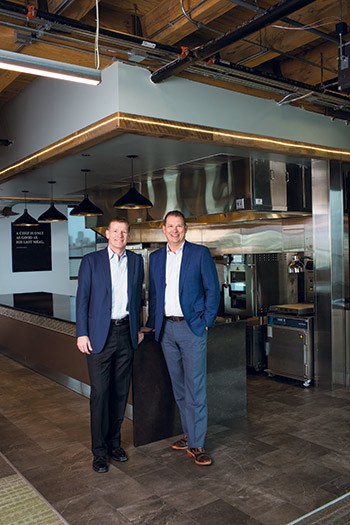 Rick and Eric BoelterMaintaining sales in excess of $300 million, along with a reputation for doing the right thing that the company carries, takes stamina, determination and a vision for the future. The leadership at Boelter can claim all three. Likewise, they now claim three FE&S Dealer of the Year awards, earning that recognition in 1990, 2005 and now again in 2018.
Rick and Eric BoelterMaintaining sales in excess of $300 million, along with a reputation for doing the right thing that the company carries, takes stamina, determination and a vision for the future. The leadership at Boelter can claim all three. Likewise, they now claim three FE&S Dealer of the Year awards, earning that recognition in 1990, 2005 and now again in 2018.
From its humble start in the heyday of the Great Depression, supplying the basics to Milwaukee-area taverns, the company hit its momentum between 1960 and 1970 when it went from $2.5 million to $12.5 million in annual sales. It’s been climbing ever since and has maintained a stable $355 million in annual sales for the past 2 years while continuing to fortify its foundation for more growth. Growth, for the most part, has always been organic. While Boelter does acquire other companies, the deals tend to be very strategic.
The company’s reputation in the industry matches its business prowess. Words like “honesty” and “integrity” come up repeatedly when talking to Boelter’s customers and suppliers, along with “authentic.” No one at Boelter takes that reputation for granted. It comes by way of a lot of hard work over many decades.
Growth
What’s changed at Boelter over the past 13 years since it last earned Dealer of the Year honors? Plenty. “Since 2005, our company has more than tripled. And when a company grows exponentially, it forces change within the business,” says Eric Boelter, a third-generation family member who serves as president of Boelter’s foodservice design division.
As a result of this exponential growth, Boelter looks considerably different than it did in 2005. For example, the company has grown strategically via acquisition. In 2015, Boelter acquired Direct South, a Georgia dealer which just three years earlier had merged with another area distributor known as Citisco. This move fortified Boelter’s presence in the Southeast and added to its government sales capabilities.
Then in 2016, Boelter acquired Premier Restaurant Equipment Company and combined it with the company’s existing operation in the Twin Cities. As a result, Minneapolis represents Boelter’s largest contract office. The acquisition of Premier also helped Boelter grow its negotiated business with independent restaurants and senior living operators in the area. Boelter also handles some bid work and intends to grow its chain business from this office, focusing on emerging concepts.
The Minneapolis office’s diverse client base and product offerings remain consistent with how the entire company approaches going to market. “We want customers where we can add value,” says Jason Prondzinski, vice president of sales. “We talk about the value we can bring them instead of just a good price.” That value proposition can include customizable solutions such as online ordering, installation, project tracking and more.
“We have diversification in our offerings from contract to supply to beverage group to brands division and more,” Prondzinski adds. “Yes, we want to grow, but we are not just a company chasing a dollar just to grow its business.”
Growing through acquisition is often easier said than done. One of the biggest challenges a company can face is fully integrating systems such as purchasing, information technology and the underlying fundamental support systems. Boelter centralizes these functions at the company’s corporate headquarters in Wisconsin. “We want to make sure we have a good set of processes, procedures and systems in place and running smoothly so we can reach the next set of goals,” says Karen Loritz, chief financial officer. “We’re trying to make sure we have solid infrastructure to take that next leap.”
Adds Anne Schepp, vice president of talent management, “A big piece of what we are trying to do is position ourselves well so when we do grow, we are ahead of the curve and not trying to catch up.”
This thoughtful approach continues to pay dividends. “We have been able to learn together,” Boelter’s Nick Adams says of Direct South’s transition to its post under the Boelter corporate umbrella. “They brought resources and expertise we did not have before.”
Culture
 Collaboration is key at Boelter. The company’s associates see themselves as part of one big team and work closely together, even across offices. Here (from front left) Jon Pointon, project manager; Tim Watson, sales rep; Jacques Cadet III, CAD/BIM specialist; Mark Garoufalis, supply sales manager and Marcy Tucker, CAD Revit specialist use one of the company’s Chicago conference rooms to review a project. To get a more detailed look at the design, a 3-D version of the drawing is visible on the screen. This space also allows for video conferencing with other Boelter offices.When Boelter brings on a company, its due diligence extends beyond the balance sheet to ensure it is a cultural fit, too. “You cannot just look at numbers. If a company is up for sale, you better believe they position their numbers in the best possible light,” says Bill Boelter, chairman of the board. “When you buy a business, it’s ultimately about the people. The culture we have is highly regarded by the companies we acquired, but maintaining that culture from afar is a challenge. We’ve had some less-than-optimal experiences surrounding acquisitions, and it goes back to culture. It just goes to show how differences in culture make a huge difference.”
Collaboration is key at Boelter. The company’s associates see themselves as part of one big team and work closely together, even across offices. Here (from front left) Jon Pointon, project manager; Tim Watson, sales rep; Jacques Cadet III, CAD/BIM specialist; Mark Garoufalis, supply sales manager and Marcy Tucker, CAD Revit specialist use one of the company’s Chicago conference rooms to review a project. To get a more detailed look at the design, a 3-D version of the drawing is visible on the screen. This space also allows for video conferencing with other Boelter offices.When Boelter brings on a company, its due diligence extends beyond the balance sheet to ensure it is a cultural fit, too. “You cannot just look at numbers. If a company is up for sale, you better believe they position their numbers in the best possible light,” says Bill Boelter, chairman of the board. “When you buy a business, it’s ultimately about the people. The culture we have is highly regarded by the companies we acquired, but maintaining that culture from afar is a challenge. We’ve had some less-than-optimal experiences surrounding acquisitions, and it goes back to culture. It just goes to show how differences in culture make a huge difference.”
In the case of Direct South, for example, the company had recently transitioned to an employee ownership program when Boelter bought it. As a result, the Direct South team brought an owner’s mindset and entrepreneurial spirit that made it a natural fit for Boelter. “I embraced having other people who could help not only me but also make our employees more successful,” Adams says. “And Boelter gives you the power to make your own decisions.”
That autonomy speaks to the continued evolution of Boelter’s management team in recent years.
“Most decisions can’t be made centrally when you grow that fast. So, Rick [Boelter] and I rely on a fantastic management team to lead with us,” Eric Boelter says. “Boelter has never been a place where we make decisions centrally that could be better made by aligned leaders and frontline associates who are closest to the action. We distribute that among our leaders, and they have to be up for the challenge of that increased responsibility. They keep Rick and me accountable and better informed about what’s happening throughout the organization. As long as those leaders are aligned with our values and are part of the strategic process, then Rick and I know those decisions will be consistent with who we are as a company. And those decisions will move us closer to our objectives.”
“We have been able to diversify and strengthen our company because of our culture,” adds Rick Boelter, president of Boelter Beverage. “It forms the root of who we are. All the diversification and opportunities we pursue in the market come from our entrepreneurial spirit.”
Boelter also made strategic hires among its executive leaders. For example, the company bolstered its ranks with the hiring of Loritz to serve as chief financial officer, Schepp to serve as vice president of talent management and Tim Brown to oversee operations. Most recently, the company added Tara Benyousky to serve as its director of marketing and creative. “We are marketing creative services to our customers and making big strides in leveraging a very talented creative and marketing team across our entire business,” Eric Boelter adds.
Prondzinski, a 25-year veteran of the foodservice equipment industry, represents another strategic addition to the Boelter team. While working on the manufacturing side of the industry from the Twin Cities, Prondzinski served as an account manager for such operator segments as airlines, catering and cruise ships. He moved away from the area to work for another manufacturer, handling national accounts. Eventually, Prondzinski moved back to Minneapolis and went on to join Boelter in 2017. “I’ve known Eric Boelter for a long time. It seems like we grew up in this industry together,” Prondzinski says. “I like the idea that the company is progressive. They are different. We share best practices across all segments of the organization, which is really helpful.”
Indeed, hiring and retaining talented people who believe in the corporate culture remains a key element in Boelter’s continued success. “There’s no secret recipe for this. We are able to keep good people because we give them the opportunity to make a difference,” Eric Boelter says. “If Rick and I are making all the decisions, we are missing out on some key opportunities. And, quite simply, the business can’t scale through just a handful of decision makers. You need good people who want to take on responsibility, want to lead and don’t want to be micromanaged.”
It’s one thing to assemble a talented team and quite another to get them all working together, but that’s exactly what Boelter has done. The individual offices all see themselves as being part of the same team and go to market with an all for one and one for all mentality. “We all truly want our individual business and the organization to be successful, and we will get there faster by working together,” Adams says.
And the individual locations work very hard to stay in close contact and support one another. “We are a phone call away and an airplane ride away,” Adams adds. “Hardly two weeks go by without someone from another division coming to see us or someone from here going to see them.”
That approach has withstood the test of time. “I’ve never had an issue I could not bounce off someone in another office,” says Rick Garavaglia, the St. Louis office team leader. Like Adams, Garavaglia joined the company as part of an acquisition back in 2004. “Someone is always there to answer your question and help out. That’s just the way it is.”
Infrastructure Investments
During a time when major retailers continue to shutter their locations, Boelter continues to invest in brick-and-mortar infrastructure as one way to differentiate the company from its competition.
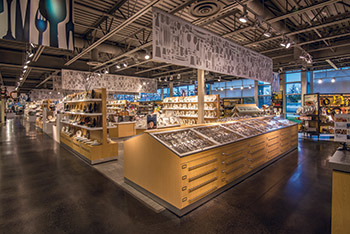 Boelter debuted its superstore format in 2008 with a flagship location in Milwaukee. The space included high-end, interactive displays of foodservice equipment and supplies.“The superstores are really customer experience centers,” Eric Boelter says. “As customers increasingly choose online channels, we have to be relevant and not engage in a race to the bottom by selling on lowest price alone. The superstores have to be a place where a customer comes in and says ‘wow!’ People have to be able to envision what they can be while they visit these locations. We have to staff these facilities with people who are aligned with our strategies. And they know when a customer comes in, it’s their job to understand their challenges and not simply show them where the smallwares section is.”
Boelter debuted its superstore format in 2008 with a flagship location in Milwaukee. The space included high-end, interactive displays of foodservice equipment and supplies.“The superstores are really customer experience centers,” Eric Boelter says. “As customers increasingly choose online channels, we have to be relevant and not engage in a race to the bottom by selling on lowest price alone. The superstores have to be a place where a customer comes in and says ‘wow!’ People have to be able to envision what they can be while they visit these locations. We have to staff these facilities with people who are aligned with our strategies. And they know when a customer comes in, it’s their job to understand their challenges and not simply show them where the smallwares section is.”
This approach dates back to the company’s first superstore location, which opened in 2008. The company opened a second superstore last year in Chicago’s Goose Island neighborhood and yet another, in Atlanta, earlier this year.
“The superstores are an advantage,” says Anne McCabe, vice president of national accounts. “People still want that see-feel-touch experience.” In an era where the internet continues to pose a huge threat to traditional foodservice equipment and supplies dealers, she believes people want to see an expert, and showrooms allow a place for those experts to hold court. She adds that it’s a way for Boelter to set itself apart.
While Boelter’s first superstore concept raised the bar for retail sales in the foodservice equipment and supplies industry, this facility had a positive impact on other aspects of the business, too. For example, moving into the first superstore proved to be a game changer for the Boelter’s Wisconsin contract team.
“The facility has a large warehouse, and it allowed us to stage our contract jobs in-house, which we could not do before,” says Steve Stern, director of foodservice design. “In the past, we would consolidate jobs at local cartage companies or warehouses. Being able to consolidate everything in-house allowed us to do the work at a lower cost. And everything else that comes with it — being able to verify that the equipment was here, inspect it and so forth — really helped.”
The move to the superstore location benefitted the contract side of the business in other ways, too. For example, this space started showcasing equipment more. And there was the addition of a culinary center. These factors brought the Boelter team closer not only to its customers but to the community it serves, too. “Being able to use the culinary center for training, public events and more was important,” Stern says. “There’s certainly value-added things we can provide. It gave everyone, from our employees to our customers, a chance to get their hands on the equipment instead of just looking at spec sheets. And the customers love it because it opened the door for them to be able to do something in real time. They can validate if they make a purchase that the equipment will work for them.”
With this enhanced infrastructure in place, the table was set for Boelter’s contract division to feast on growing business opportunities in Wisconsin that span a variety of operator segments such as hospitality, restaurants, senior living and even publicly funded projects like K-12 schools. “A lot of that work comes from our relationships we have developed with architects over the years,” Stern says.
The Chicago superstore includes a retail space stocked with smallwares, tabletop items and the like on one side of the first floor. The other side of the floor hosts an equipment showroom and a bar area. The second floor includes office space for the Boelter sales teams, and the third floor features a 5,000-square-foot event space complete with a test kitchen. This area can accommodate up to 80 people for training classes and 150 people for events, which can include dinner and cocktails. “It’s a great opportunity for us here, and we are taking advantage of it,” says Eric Chaplick, director of foodservice design and equipment in Boelter’s Chicago office.
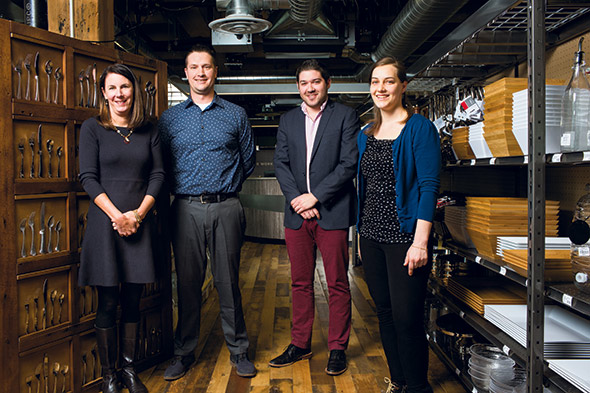 Boelter staffs its superstores with team members aligned with the company’s strategies and who can serve as consultants instead of those who simply guide customers to the smallwares section. Seen here is the team from the Chicago superstore: (left to right): Sheila Watson, Russ Streett, Patrick Mangan and Jenn Heineman.
Boelter staffs its superstores with team members aligned with the company’s strategies and who can serve as consultants instead of those who simply guide customers to the smallwares section. Seen here is the team from the Chicago superstore: (left to right): Sheila Watson, Russ Streett, Patrick Mangan and Jenn Heineman.
For example, Boelter uses the facility to train its team on the latest equipment. “We don’t have to send our people around the country,” Chaplick explains. “Most of our seasoned people know about a factory’s existing products, so we can focus on new products.” After they train on it, Boelter associates pay that information forward. “We conduct 15- to 20-person training sessions, showing them how to use the equipment.”
The Chicago superstore’s proximity to the city’s downtown area allows the dealer to stay close to many of its customers, offering them a convenient learning option. “We work with lots of contract feeders downtown, and they can send people over to learn about new equipment,” Chaplick says.
In addition, Boelter uses the space to host a variety of social events. For example, this past October, the company hosted an event it dubbed Paired, which featured area breweries and restaurants showcasing Oktoberfest offerings. As guests sampled food, they browsed informational tables covering bar design, glassware, proper beer temp and more.
Events like these represent the way Boelter strives to add value on the customers’ terms by trying to curate impactful experiences that extend beyond the price of a product. “If you continue to just be the lowest-price provider and buy business, you set yourself up for disaster,” Chaplick says. “Everyone can match a price. And today’s customers are far more intelligent and have far more access to information than before. We want to understand what they want to cook, how fast and what image they want to convey to their customers. It’s about matching the right equipment with the right application, and that’s where the knowledge part comes into play.”
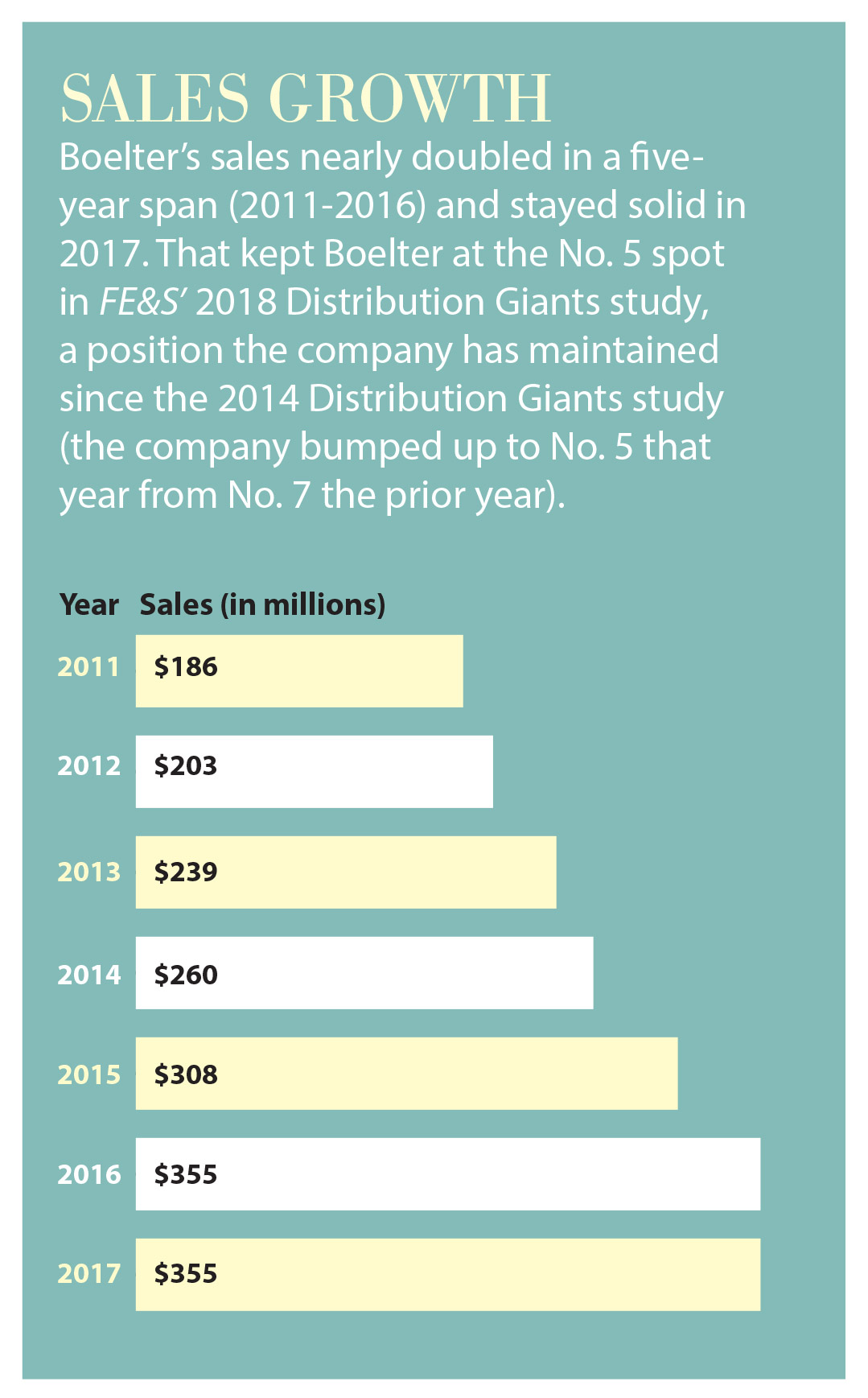 Boelter has similar plans for the newly opened Atlanta facility. This 14,000-square-foot location, which used to serve as a training facility for a big-box retailer that makes its home in the Atlanta market, features a spacious showroom, a test kitchen and an event space.
Boelter has similar plans for the newly opened Atlanta facility. This 14,000-square-foot location, which used to serve as a training facility for a big-box retailer that makes its home in the Atlanta market, features a spacious showroom, a test kitchen and an event space.
“It has a design and ambience that’s unique to Atlanta. We are focused on providing people with a unique and positive experience,” Adams says. “When people talk about what keeps them up at night, we want to be able to help them. If they want to test a product or a piece of equipment, we can support them. They can bring in a piece of equipment; we can hook it up for them so they can test it and work with their people without disrupting their operation.”
Continuing to invest in infrastructure like the Chicago and Atlanta superstores sends a clear message to current and potential clients. “The message we are trying to send is that we want to be with our customers throughout the entire life cycle of their business,” Adams says. “We want to provide a convenient experience that allows them to kick the tires on equipment and other items while also taking advantage of our other services like design. If someone comes in and wants to design a restaurant, we can take them from the front of the house to the back of the house and then help them design the space.”
But not all of Boelter’s investments are brick-and-mortar oriented.
Boelter Blue marks the company’s newest product offering, the result of its October 2016 acquisition of Anchor 5 Digital. The restaurant app provides a unique value proposition, yet another component that Boelter’s competitors would have a difficult time emulating. The app supports restaurant operators with custom marketing messages, helps create engagement and facilitates frequent-guest rewards programs.
“It’s a way that our customers can reach their customers, relatively easily and inexpensively,” says Paul Burgoyne, vice president of sales, the supply division, and a 15-year Boelter veteran. “We’re the only distributor offering something like this, and it was designed for one reason: In today’s world, we are trying to separate ourselves from everyone else. Every customer is different. We try and tailor customized programs to meet specific needs.” He views both the new Boelter Blue app and Boelter’s showrooms as great tools to do that.
Boelter Blue provides an insight into the unique way the company views itself. “The move into the technology space — one that’s tangential to the foodservice space — was the result of our strategic plan. We have to continue to evolve and innovate as a company,” Eric Boelter says. “When you think and operate that way, you see things through a different lens. The way we characterize our business affects what we see as opportunities. If we are going to succeed into the future, we can’t define our business as one that only buys equipment, specifies product or even designs foodservice operations. Those things are important, but more and more, we define our business as we are here to help our customers be better and more profitable.”
The company’s technology investment goes beyond Boelter Blue. Like other dealers, Boelter continues to migrate toward using BIM in its designs. “We are moving that way. We have to,” Stern says. “It’s being driven by architects that are asking us to do the same.” Using BIM also enhances operator engagement throughout the design process. “A lot of customers have a difficult time being able to read a two-dimensional plan,” he adds. “So having that 3-D capability helps them understand the design.”
Back to Culture
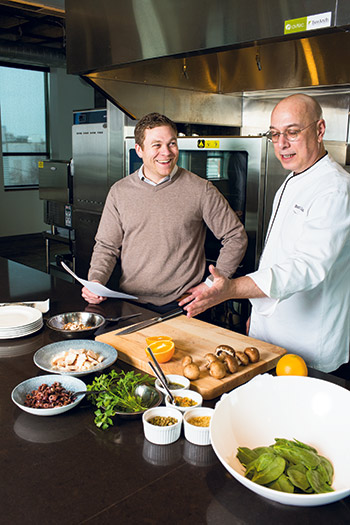 The test kitchens at Boelter’s superstores get a workout. Here consulting chef Randy Zweiban (right) discusses a menu solution with David Vanderbaan, outside sales rep.It’s easy to focus on the things that change within a company over time, but the secret to Boelter’s success may be the company’s one constant: its culture. The company’s current management team continues to maintain an atmosphere of thoughtful hard work established by company founder Fred Boelter. Equally as important, though, is the servant leadership culture that Bill Boelter helped establish during his tenure as company president and that Eric and Rick continue to nurture today.
The test kitchens at Boelter’s superstores get a workout. Here consulting chef Randy Zweiban (right) discusses a menu solution with David Vanderbaan, outside sales rep.It’s easy to focus on the things that change within a company over time, but the secret to Boelter’s success may be the company’s one constant: its culture. The company’s current management team continues to maintain an atmosphere of thoughtful hard work established by company founder Fred Boelter. Equally as important, though, is the servant leadership culture that Bill Boelter helped establish during his tenure as company president and that Eric and Rick continue to nurture today.
“Our strength is derived in who we want to be as an organization, which is linked to our culture,” Eric Boelter says. “Our values guide our strategy. People who come into our organization bring with them positive change and new ideas. But the one thing that remains constant is our values.
“As we have grown, we have tried to be intentional in staying a family business,” Eric Boelter adds. “Not in a sense of who owns the company, but does it feel like a family business? And as you grow, that can be challenging. The sense of big corporate takes over. And we are taking steps to push back against those tendencies.”
None of this is lost on the company’s associates. “Rick and Eric continue to emphasize trusting one another and making sure you have fun,” Stern says. “We were at a NAFEM Show, spending time with the other divisions, and one of my people pointed out how much the Direct South people are just like us. It shows that Eric has done his due diligence and wants to bring on people who will fit into our culture, which makes this company so successful. Eric wants to build a foundation that will sustain this culture and business moving forward.”
That foundation includes providing training to current employees as well as being active in the community and even advocating for careers in foodservice. For example, Stern spoke to dietary students at the University of Wisconsin – Green Bay about the fundamental aspects of a commercial kitchen. He also took some time to educate the audience about the myriad opportunities available to them in the foodservice industry. “I told them if you like foodservice, there are other career paths in addition to being a dietician. And people were genuinely interested in that,” he says. “Part of it is the culture, and part of it is our industry. The hospitality industry is fun.”
Communication plays a key role in supporting Boelter’s culture, and it starts at the top and permeates the entire enterprise. Internally, Eric and Rick are often referred to as The Boelters, which reflects the in-sync leadership in which the brothers operate. That tone of inclusion extends throughout the entire Boelter team, going well beyond C-suite executives.
“There are no secrets at Boelter,” says McCabe, a 31-year company veteran. “We are all very transparent with each other.”
But remaining transparent in a company that now has operations in six different states can be tricky. “Having offices all around the country is very, very challenging from the standpoint of aligning everyone,” says Rick Boelter. “There was some key learning around that when we had our first acquisition outside our core Midwest area. It taught us the importance of having great leadership remotely, and that was huge. Now, as we pursue growth opportunities, we look at leadership, either as it already exists at that company or how we will build it.”
Boelter places a heavy emphasis on keeping everyone on the same page internally, particularly when it comes to change. “How you communicate what’s happening in the organization becomes more and more important,” Eric Boelter says.
To help associates continue to see the big picture, Boelter hosts quarterly simulcasts to all of its locations. “We review the key strategic objectives that we have as an organization that are not unique to one specific business unit,” Eric Boelter says. And to keep things light, a business unit might make a five-minute video about how they are meeting objectives to share with the company during these meetings.
On top of the corporate transparency, both Eric and Rick seek others’ opinions and conflicting views. “So often, leaders choose people exactly like them,” says Loritz, who recently hit the one-year mark at the company. “It’s easy to do that; there is a lot less debate. Instead, Rick and Eric are very deliberate in having the right people in place to be their co-pilots. They bring people on board that complement their strengths and weaknesses.”
This, too, is intentional and critical to the company’s long-term success. “Our leadership in the organization works to hold my brother and me accountable,” Eric Boelter adds.
One of the things that attracted Loritz to Boelter was a strong sense of ethics and integrity. Having previously worked for public companies, she notes that Rick and Eric are “in it for the long haul” and that the company is not constrained by the quarterly shareholder requirements she often found the center of concern at public companies.
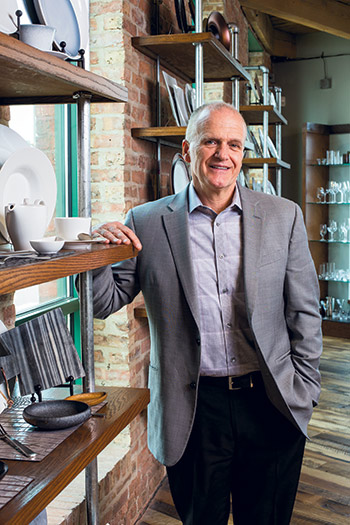 Tim Scott is vice president and general manager of Boelter Supply.Tim Scott, a Boelter vice president and general manager of the supply division, agrees with Loritz’s assessment of Eric and Rick. A seven-year Boelter veteran, he says they “encourage me to not be afraid to point things out and argue with them.” He views that as a huge strength.
Tim Scott is vice president and general manager of Boelter Supply.Tim Scott, a Boelter vice president and general manager of the supply division, agrees with Loritz’s assessment of Eric and Rick. A seven-year Boelter veteran, he says they “encourage me to not be afraid to point things out and argue with them.” He views that as a huge strength.
“Everyone has easy accessibility to the owners,” adds Schepp. “There is not a hierarchy of layers.”
As a result, turnover is not a problem for Boelter. “We have a lot of people who been with us a long time,” Chaplick says. “So long as they like what they do and feel they can make a living at it, they will stay. But we are always looking to grow by adding young and exciting talent.”
“It’s all about the culture and not all about the numbers all the time,” Prondzinski adds. “Eric Boelter is so adamant about that culture. We are looking to hire people, but it has to be the right person who is the right fit at the right time. If they are going to be disruptive to the organization, we don’t want them. At the end of the day, we are a family-owned business, and that allows us time to get it right.”
It does not hurt that the company is not afraid to promote from within, too. For example, one Chicago office associate earned a promotion from working on the store floor to the design division, where he now works alongside a company veteran. “It’s a perfect match,” Chaplick says. “The experienced associate is excited to share his knowledge, and the younger associate is excited to learn from him. I encourage young Boelter associates to learn from as many people as possible, take little bits from each of them and turn that into your way of doing business. If you do that, it won’t take as long for you to learn and become self-sufficient.”
The end goal of this training, though, remains focused on the customer. “Learn how to sit in front of a customer to learn what their dream is,” Chaplick says. “You can sketch it out, write the spec and be there for the entire process. Then, you are part of something from start to finish, and that’s something special.”
Indeed, Boelter associates’ ability to show empathy for their operator customers remains a distinguishing factor for the company. “People come to us because we are going to take the time to sit with them to understand their business,” Chaplick says. “The customer who calls in and asks, ‘Can you sell me a refrigerator, and what’s your price?’ — the first thing we should say is, ‘Tell me about your business and how you are using this equipment.’ Then, we engage them by asking if we can come see their business or have them come to us. If you can engage them and show you can bring something to the table, then they understand you are not just trying to sell them a piece of equipment.”
Boelter’s open and honest communication extends to its supply chain partners, too. “It’s the experience we want to provide all of our stakeholders. Trust and transparency don’t happen on their own. We have chosen key suppliers to work with, and we strive to always be better communicators,” Eric Boelter says. “That helps us to get across the finish line together, which is what we want. If we work hard to sell a supplier’s products, we want to know they are working hard for us, too.”
Despite its rapid growth — both financially and geographically — Boelter strives to maintain the warm atmosphere only a family business can have. And it starts at the top. “The owners know your name. He walks into the building and says, ‘Hello, I am Eric. How are you?’ ” Chaplick says. “He treats everyone equally — from the guy unloading a truck to the CAD operator to the $5 million salesman.”
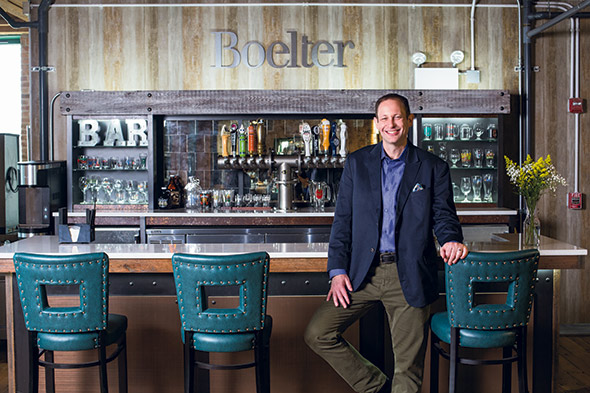 Eric Chaplick is director of foodservice design and equipment in Boelter’s Chicago office.
Eric Chaplick is director of foodservice design and equipment in Boelter’s Chicago office.
But this is about more than a warm smile and a handshake. “It’s important to know people personally. We want to know them, and you do need to be intentional about it,” says Eric Boelter. “You speak by your actions and not by what you say. You have to be approachable. People need to be able to come talk to me and Rick and feel good about it. It’s knowing you can make a difference no matter your role. We don’t allow process and standardization of process, which are important as you grow, to trump the customer experience. We need to have our people be agile. There’s nothing I hate more than when someone says ‘corporate this’ or ‘corporate that.’ It tells me we are not doing something right.”
This next-level thinking clearly resonates with some of Boelter’s newest associates. “One of the reasons I bought into the idea of us coming together was because of the culture,” Adams says. “I wanted to take us to more of a servant-led culture. Boelter had certainly initiated that years before. I felt they could help us get there faster.”
Some companies speak of an all for one, one for all mentality but often struggle to practice what they preach. At Boelter, though, that’s standard operating procedure. “Ultimately, the success we have with a customer can’t be about individual heroics. If we succeed, we do it together, and if we lose, we do it as a team,” Eric Boelter says.
Much of this stems from the company’s thoughtful approach to integration, both with acquisitions and existing divisions. Indeed, Boelter’s various divisions see themselves as one big — and getting bigger — group of siblings. And that’s how they all go to market. “Our company is not segregated. If I have a guy in Minnesota that needs help with a project, I do it,” Chaplick says. “It’s not like that in other companies. But we’re all Boelter, and that’s what it comes down to.”
 A key component in Boelter’s success is its marketing team, which includes Tara Benyousky, marketing director (left) and Carolyn Statz, marketing manager. The marketing team develops first-class strategies and collateral that demonstrate the company’s competencies, capabilities and more.Still, working across offices that span multiple time zones and disciplines will continue to be a challenge — but the Boelter team acknowledges that and seems ready to tackle it. “How do you find synergy and leverage that across the board? It’s not that easy, but we continue to get better and better at this,” Prondzinski says.
A key component in Boelter’s success is its marketing team, which includes Tara Benyousky, marketing director (left) and Carolyn Statz, marketing manager. The marketing team develops first-class strategies and collateral that demonstrate the company’s competencies, capabilities and more.Still, working across offices that span multiple time zones and disciplines will continue to be a challenge — but the Boelter team acknowledges that and seems ready to tackle it. “How do you find synergy and leverage that across the board? It’s not that easy, but we continue to get better and better at this,” Prondzinski says.
“They treat everyone with respect. They value the relationship they have with their customers and their vendors, and it shows every day,” Prondzinski says. “It’s always honest. And there’s nobody better at it than Boelter. That’s why customers keep coming back.”
Regardless of title or rank, Boelter employees are all empowered to do what is best for the customer. In his role as director of operations for Boelter’s foodservice equipment and supply division and Boelter’s beverage division, Brown regularly encounters this. “If an associate has a customer on the phone and needs to make a decision, they are empowered to make the right decision instead of being forced to escalate the decision up [the corporate ladder] and wait for a decision to cascade back down.”
Brown adds that Boelter regularly offers support, guidance, coaching and mentoring to find out what professional development each person needs to support that kind of empowered decision making. “If there is an urgent need and a decision to be made, our people are equipped to make that decision on the fly. You don’t have time to ask permission.”
What does the future hold for Boelter? Another look back at its past likely foreshadows what’s to come. “My grandfather and father never ran Boelter for their own personal enrichment. It was always about something bigger,” Eric Boelter says. “As my father mentored us coming up through the business, he taught us it was always about the people, not us.
“You will see a continued commitment to grow and grow properly. We will continue to work as a servant leadership-driven organization, and we will continue to look for nontraditional ways to serve our customers. Whatever will be in the future, our success will depend on whether we stay true to our values and our culture. And we have to keep that entrepreneurial spirit alive that says anything is possible through hard work. If we keep that alive in every associate, I like our chances.”



